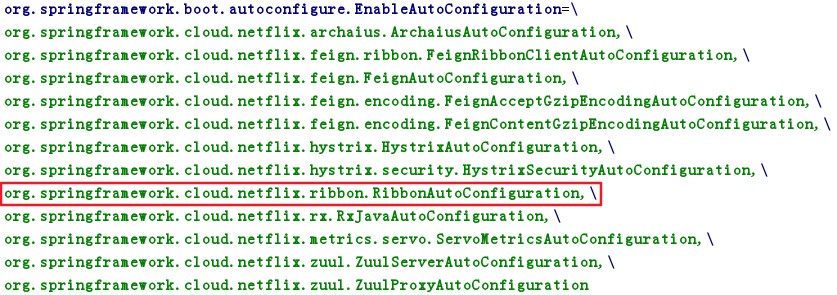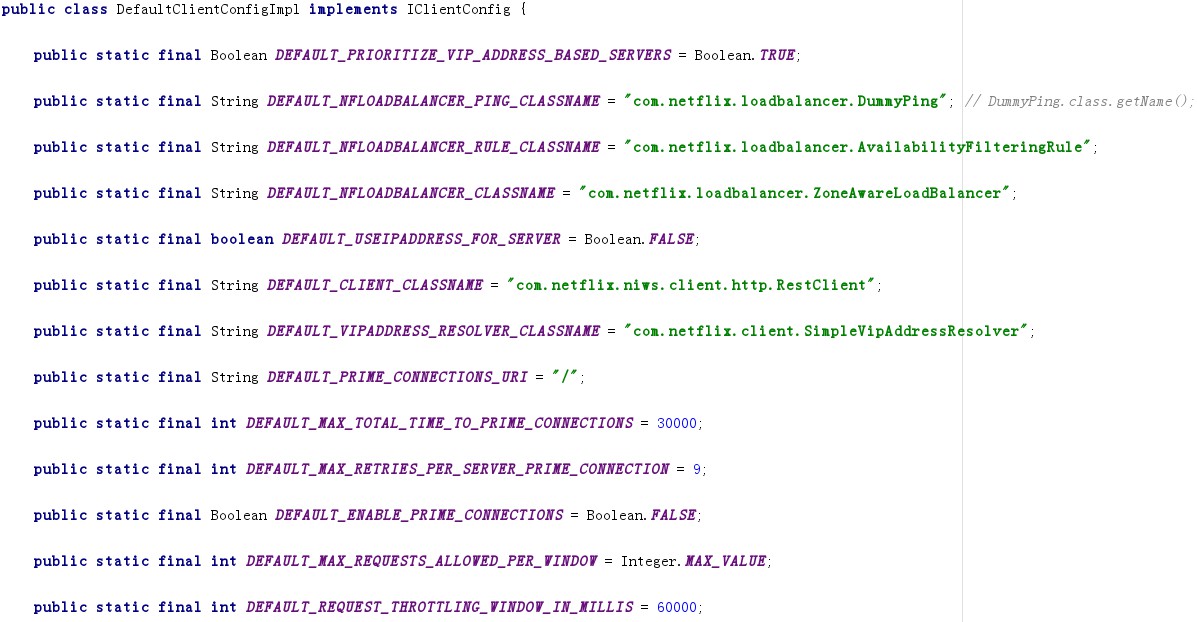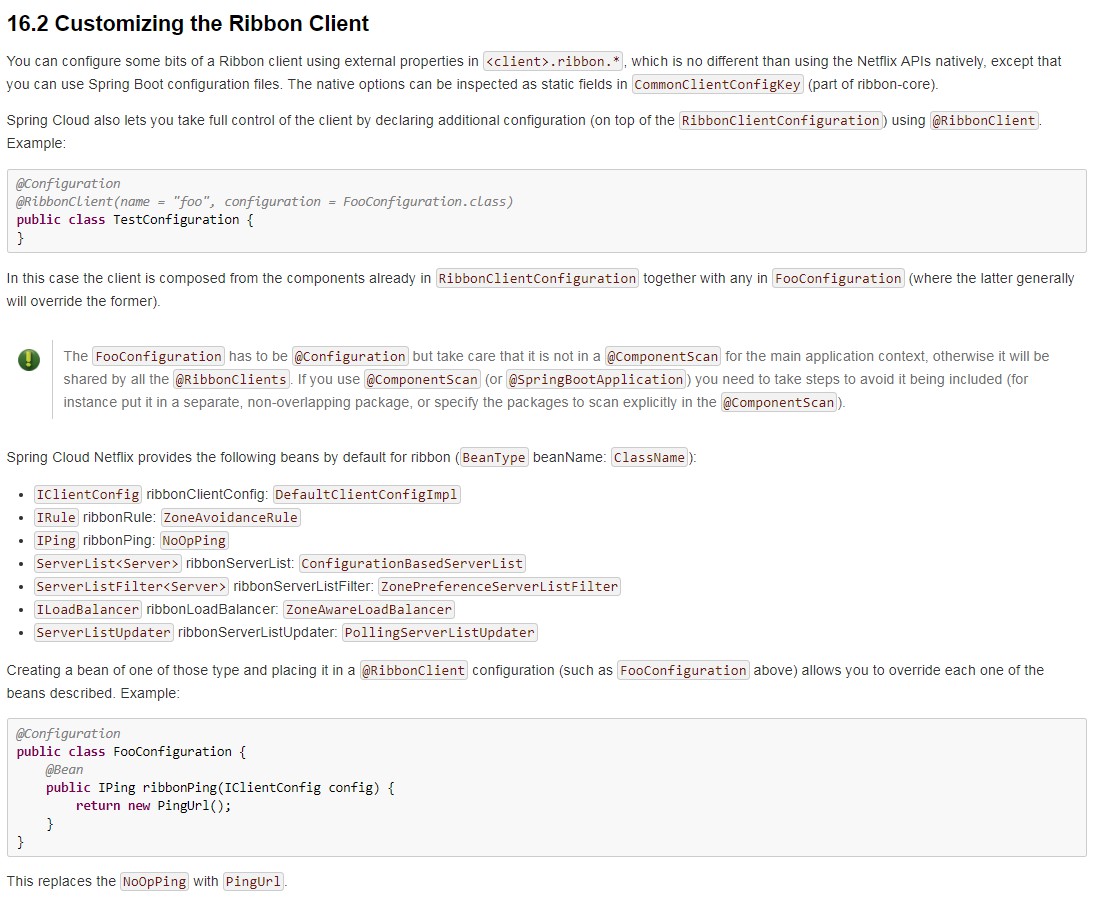转载 https://www.cnblogs.com/trust-freedom/p/11216280.html
起因
事情的起因是这样的,公司内部要实现基于Zuul网关的灰度路由,在上线时进行灰度测试,故需要配置业务微服务向Eureka注册的metadata元数据,和自定义Ribbon的负载规则达到只访问灰度服务的目的。这样就需要自定义Ribbon的IRule,实现灰度请求只会负载到带有灰度标签元数据的业务微服务上,当自定义IRule规则开发好后,问题是如何将这个IRule规则配置给某个Ribbon Client或者全局生效。
本次使用Spring Cloud Dalston.SR5版本
在其 官方文档 中其实已经给出了一些如何针对某个Client 或者 修改默认配置的方式,但没有说明为什么这样使用
下面将按照这样的思路分析:
- 简单分析Spring Cloud Ribbon启动时如何自动配置的,以了解其装配到Spring中的Bean
- Spring Cloud Ribbon Client的懒加载
- Spring Cloud Ribbon Client的配置加载,包含全局配置及Client配置
- 如何自定义Client配置、全局配置
- 解释官方文档中的一些注意事项
Spring Cloud Ribbon自动配置
当前版本中的Netflix所有自动配置都在spring-cloud-netflix-core-xxx.jar中,根据其META-INF/spring.factories中的配置得知,Spring Cloud Ribbon的自动配置类为 RibbonAutoConfiguration
RibbonAutoConfiguration
@Configuration
@ConditionalOnClass({ IClient.class, RestTemplate.class, AsyncRestTemplate.class, Ribbon.class})
@RibbonClients
@AutoConfigureAfter(name = "org.springframework.cloud.netflix.eureka.EurekaClientAutoConfiguration")
@AutoConfigureBefore({LoadBalancerAutoConfiguration.class, AsyncLoadBalancerAutoConfiguration.class})
@EnableConfigurationProperties(RibbonEagerLoadProperties.class)
public class RibbonAutoConfiguration {
// 所有针对某个RibbonClient指定的配置
@Autowired(required = false)
private List<RibbonClientSpecification> configurations = new ArrayList<>();
// ribbon是否懒加载的配置文件
@Autowired
private RibbonEagerLoadProperties ribbonEagerLoadProperties;
// Spring会给每个RibbonClient创建独立的ApplicationContext上下文
// 并在其上下文中创建RibbonClient对应的Bean:如IClient、ILoadbalancer等
@Bean
public SpringClientFactory springClientFactory() {
SpringClientFactory factory = new SpringClientFactory();
factory.setConfigurations(this.configurations);
return factory;
}
// Spring创建的带负载均衡功能的Client,会使用SpringClientFactory创建对应的Bean和配置
@Bean
@ConditionalOnMissingBean(LoadBalancerClient.class)
public LoadBalancerClient loadBalancerClient() {
return new RibbonLoadBalancerClient(springClientFactory());
}
// 到Spring environment中加载针对某个Client的Ribbon的核心接口实现类
@Bean
@ConditionalOnMissingBean
public PropertiesFactory propertiesFactory() {
return new PropertiesFactory();
}
// 如果不是懒加载,启动时就使用RibbonApplicationContextInitializer加载并初始化客户端配置
@Bean
@ConditionalOnProperty(value = "ribbon.eager-load.enabled", matchIfMissing = false)
public RibbonApplicationContextInitializer ribbonApplicationContextInitializer() {
return new RibbonApplicationContextInitializer(springClientFactory(),
ribbonEagerLoadProperties.getClients());
}
......
}
上面RibbonAutoConfiguration创建的Bean主要分以下几类:
- 为Ribbon Client创建环境及获取配置
- SpringClientFactory: 会给每个Ribbon Client创建一个独立的Spring应用上下文ApplicationContext,并在其中加载对应的配置及Ribbon核心接口的实现类
- PropertiesFactory: 用于从Spring enviroment环境中获取针对某个Ribbon Client配置的核心接口实现类,并实例化
- 创建
RibbonLoadBalancerClient,并将springClientFactory注入,方便从中获取对应的配置及实现类,RibbonLoadBalancerClient是Spring对LoadBalancerClient接口的实现类,其execute()方法提供客户端负载均衡能力 - 懒加载相关
- RibbonEagerLoadProperties: 懒加载配置项Properties,可以指定是否懒加载,及哪些Client不懒加载
- RibbonApplicationContextInitializer: 启动时就加载RibbonClient配置(非懒加载)的初始化器
可以看到默认启动流程中并没有加载RibbonClient的上下文和配置信息,而是在使用时才加载,即懒加载
Spring Cloud RibbonClient的懒加载
既然是在使用时才会加载,那么以Zuul网关为例,在其RibbonRoutingFilter中会创建RibbonCommand,其包含了Ribbon的负载均衡
//## RibbonRoutingFilter Zuul负责路由的Filter
public class RibbonRoutingFilter extends ZuulFilter {
@Override
public Object run() {
RequestContext context = RequestContext.getCurrentContext();
this.helper.addIgnoredHeaders();
try {
RibbonCommandContext commandContext = buildCommandContext(context);
ClientHttpResponse response = forward(commandContext);
setResponse(response);
return response;
}
catch (ZuulException ex) {
throw new ZuulRuntimeException(ex);
}
catch (Exception ex) {
throw new ZuulRuntimeException(ex);
}
}
protected ClientHttpResponse forward(RibbonCommandContext context) throws Exception {
Map<String, Object> info = this.helper.debug(context.getMethod(),
context.getUri(), context.getHeaders(), context.getParams(),
context.getRequestEntity());
// 使用ribbonCommandFactory创建RibbonCommand
RibbonCommand command = this.ribbonCommandFactory.create(context);
try {
ClientHttpResponse response = command.execute();
this.helper.appendDebug(info, response.getStatusCode().value(),
response.getHeaders());
return response;
}
catch (HystrixRuntimeException ex) {
return handleException(info, ex);
}
}
}在执行RibbonRoutingFilter#run()进行路由时会执行forward()方法,由于此处是在HystrixCommand内部执行Ribbon负载均衡调用,故使用ribbonCommandFactory创建RibbonCommand,Ribbon客户端的懒加载就在这个方法内,这里我们看HttpClientRibbonCommandFactory实现类
//## org.springframework.cloud.netflix.zuul.filters.route.apache.HttpClientRibbonCommandFactory
public class HttpClientRibbonCommandFactory extends AbstractRibbonCommandFactory {
@Override
public HttpClientRibbonCommand create(final RibbonCommandContext context) {
ZuulFallbackProvider zuulFallbackProvider = getFallbackProvider(context.getServiceId());
final String serviceId = context.getServiceId();
// 通过SpringClientFactory获取IClient接口实例
final RibbonLoadBalancingHttpClient client = this.clientFactory.getClient(
serviceId, RibbonLoadBalancingHttpClient.class);
client.setLoadBalancer(this.clientFactory.getLoadBalancer(serviceId));
return new HttpClientRibbonCommand(serviceId, client, context, zuulProperties, zuulFallbackProvider,
clientFactory.getClientConfig(serviceId));
}
}创建RibbonLoadBalancingHttpClient的逻辑在 SpringClientFactory#getClient(serviceId, RibbonLoadBalancingHttpClient.class),如下:
- SpringClientFactory#getInstance(name, clientClass)
- NamedContextFactory#getInstance(name, type):
- 获取Client对应的ApplicationContext,如没有则调用createContext()创建,其中包含注册统一默认配置类RibbonClientConfiguration,或@RibbonClient、@RibbonClients(defaultConfiguration=xxx) 设置的配置类的逻辑
- 从ApplicationContext中根据类型获取实例,如没有使用反射创建,并通过IClientConfig配置
- NamedContextFactory#getInstance(name, type):
如上执行完毕RibbonClient就基本懒加载完成了,就可以到RibbonClient对应的ApplicationContext中继续获取其它核心接口的实现类了,这些实现类都是根据 默认/全局/Client自定义 配置创建的
//## org.springframework.cloud.netflix.ribbon.SpringClientFactory
public class SpringClientFactory extends NamedContextFactory<RibbonClientSpecification> {
static final String NAMESPACE = "ribbon";
public SpringClientFactory() {
super(RibbonClientConfiguration.class, NAMESPACE, "ribbon.client.name");
}
/**
* Get the rest client associated with the name.
* @throws RuntimeException if any error occurs
*/
public <C extends IClient<?, ?>> C getClient(String name, Class<C> clientClass) {
return getInstance(name, clientClass);
}
// name代表当前Ribbon客户端,type代表要获取的实例类型,如IClient、IRule
@Override
public <C> C getInstance(String name, Class<C> type) {
// 先从父类NamedContextFactory中直接从客户端对应的ApplicationContext中获取实例
// 如果没有就根据IClientConfig中的配置找到具体的实现类,并通过反射初始化后放到Client对应的ApplicationContext中
C instance = super.getInstance(name, type);
if (instance != null) {
return instance;
}
IClientConfig config = getInstance(name, IClientConfig.class);
return instantiateWithConfig(getContext(name), type, config);
}
// 使用IClientConfig实例化
static <C> C instantiateWithConfig(AnnotationConfigApplicationContext context,
Class<C> clazz, IClientConfig config) {
C result = null;
try {
// 通过以IClientConfig为参数的构造创建clazz类实例
Constructor<C> constructor = clazz.getConstructor(IClientConfig.class);
result = constructor.newInstance(config);
} catch (Throwable e) {
// Ignored
}
// 如果没创建成功,使用无惨构造
if (result == null) {
result = BeanUtils.instantiate(clazz);
// 调用初始化配置方法
if (result instanceof IClientConfigAware) {
((IClientConfigAware) result).initWithNiwsConfig(config);
}
// 处理自动织入
if (context != null) {
context.getAutowireCapableBeanFactory().autowireBean(result);
}
}
return result;
}
}
//## 父类 org.springframework.cloud.context.named.NamedContextFactory
public abstract class NamedContextFactory<C extends NamedContextFactory.Specification>
implements DisposableBean, ApplicationContextAware {
// 维护Ribbon客户端对应的ApplicationContext上下文
private Map<String, AnnotationConfigApplicationContext> contexts = new ConcurrentHashMap<>();
// 维护Ribbon客户端的@Configuration配置类
private Map<String, C> configurations = new ConcurrentHashMap<>();
private ApplicationContext parent;
private Class<?> defaultConfigType; // 默认配置类为 RibbonClientConfiguration
private final String propertySourceName; // 默认为 ribbon
private final String propertyName; // 默认读取RibbonClient名的属性为ribbon.client.name
public NamedContextFactory(Class<?> defaultConfigType, String propertySourceName,
String propertyName) {
this.defaultConfigType = defaultConfigType;
this.propertySourceName = propertySourceName;
this.propertyName = propertyName;
}
// 如果包含Client上下文直接返回
// 如果不包含,调用createContext(name),并放入contexts集合
protected AnnotationConfigApplicationContext getContext(String name) {
if (!this.contexts.containsKey(name)) {
synchronized (this.contexts) {
if (!this.contexts.containsKey(name)) {
this.contexts.put(name, createContext(name));
}
}
}
return this.contexts.get(name);
}
// 创建名为name的RibbonClient的ApplicationContext上下文
protected AnnotationConfigApplicationContext createContext(String name) {
AnnotationConfigApplicationContext context = new AnnotationConfigApplicationContext();
// configurations集合中是否包含当前Client相关配置类,包含即注入到ApplicationContext
if (this.configurations.containsKey(name)) {
for (Class<?> configuration : this.configurations.get(name)
.getConfiguration()) {
context.register(configuration);
}
}
//configurations集合中是否包含default.开头的通过@RibbonClients(defaultConfiguration=xxx)配置的默认配置类
for (Map.Entry<String, C> entry : this.configurations.entrySet()) {
if (entry.getKey().startsWith("default.")) {
for (Class<?> configuration : entry.getValue().getConfiguration()) {
context.register(configuration);
}
}
}
// 注册PropertyPlaceholderAutoConfiguration、RibbonClientConfiguration
context.register(PropertyPlaceholderAutoConfiguration.class,
this.defaultConfigType);
// 添加 ribbon.client.name=具体RibbonClient name的enviroment配置
context.getEnvironment().getPropertySources().addFirst(new MapPropertySource(
this.propertySourceName,
Collections.<String, Object> singletonMap(this.propertyName, name)));
// 设置父ApplicationContext,这样可以使得当前创建的子ApplicationContext可以使用父上下文中的Bean
if (this.parent != null) {
// Uses Environment from parent as well as beans
context.setParent(this.parent);
}
context.refresh(); //刷新Context
return context;
}
public <T> T getInstance(String name, Class<T> type) {
AnnotationConfigApplicationContext context = getContext(name);
if (BeanFactoryUtils.beanNamesForTypeIncludingAncestors(context,
type).length > 0) {
return context.getBean(type);
}
return null;
}
}上面比较重要的就是在创建每个RibbonClient的ApplicationContext的createContext(name)方法,其中包含了根据哪个@Configuration配置类创建Ribbon核心接口的实现类的逻辑,故需重点分析(Ribbon核心接口讲解 参考)
那么在createContext(name)方法创建当前Ribbon Client相关的上下文,并注入配置类时,除了默认配置类RibbonClientConfiguration是写死的,其它的配置类,如default全局配置类,针对某个Ribbon Client的配置类,又是怎么配置的呢?
Spring Cloud RibbonClient的配置加载,包含全局配置及Client配置
创建RibbonClient对应ApplicationContext,并注册所有可用的Configuration配置类
//## org.springframework.cloud.context.named.NamedContextFactory#createContext()
protected AnnotationConfigApplicationContext createContext(String name) {
AnnotationConfigApplicationContext context = new AnnotationConfigApplicationContext();
// 1、注册专门为RibbonClient指定的configuration配置类,@RibbonClient注解
if (this.configurations.containsKey(name)) {
for (Class<?> configuration : this.configurations.get(name)
.getConfiguration()) {
context.register(configuration);
}
}
// 2、将为所有RibbonClient的configuration配置类注册到ApplicationContext
for (Map.Entry<String, C> entry : this.configurations.entrySet()) {
if (entry.getKey().startsWith("default.")) {
for (Class<?> configuration : entry.getValue().getConfiguration()) {
context.register(configuration);
}
}
}
// 3、注册defaultConfigType,即Spring的默认配置类 RibbonClientConfiguration
context.register(PropertyPlaceholderAutoConfiguration.class,
this.defaultConfigType);
context.getEnvironment().getPropertySources().addFirst(new MapPropertySource(
this.propertySourceName,
Collections.<String, Object> singletonMap(this.propertyName, name)));
if (this.parent != null) {
// Uses Environment from parent as well as beans
context.setParent(this.parent);
}
context.refresh(); // 刷新上下文
return context;
}根据如上逻辑可以看出会从3个地方将Ribbon相关的Configuration配置类注册到专门为其准备的ApplicationContext上下文,并根据配置类创建Ribbon核心接口的实现类,即达到配置RibbonClient的目的
- 从configurations这个Map中根据RibbonClient name获取专门为其指定的configuration配置类,并注册到其对应的ApplicationContext上下文
- 从configurations这个Map中找到 default. 开头 的配置类,即为所有RibbonClient的默认配置,并注册到其对应的ApplicationContext上下文
- 如果不是开发者单独指定的话,前两项都是没有数据的,还会注册Spring Cloud的默认配置类
RibbonClientConfiguration
那么configurations这个Map里的配置类数据是从哪儿来的呢??下面逐步分析
//## RibbonAutoConfiguration
@Autowired(required = false)
private List<RibbonClientSpecification> configurations = new ArrayList<>();
@Bean
public SpringClientFactory springClientFactory() {
SpringClientFactory factory = new SpringClientFactory();
factory.setConfigurations(this.configurations);
return factory;
}首先是在RibbonAutoConfiguration自动配置类创建SpringClientFactory是设置的,这个configurations集合是@Autowired的Spring容器内的RibbonClientSpecification集合,那么RibbonClientSpecification集合是何时被注册的??
//## org.springframework.cloud.netflix.ribbon.RibbonClientConfigurationRegistrar
public class RibbonClientConfigurationRegistrar implements ImportBeanDefinitionRegistrar {
@Override
public void registerBeanDefinitions(AnnotationMetadata metadata,
BeanDefinitionRegistry registry) {
// 1、@RibbonClients注解
Map<String, Object> attrs = metadata.getAnnotationAttributes(
RibbonClients.class.getName(), true);
// 1.1 value是RibbonClient[],遍历针对具体的RibbonClient配置的configuration配置类,并注册
if (attrs != null && attrs.containsKey("value")) {
AnnotationAttributes[] clients = (AnnotationAttributes[]) attrs.get("value");
for (AnnotationAttributes client : clients) {
registerClientConfiguration(registry, getClientName(client),
client.get("configuration"));
}
}
// 1.2 找到@RibbonClients注解的defaultConfiguration,即默认配置
// 注册成以default.Classname.RibbonClientSpecification为名的RibbonClientSpecification
if (attrs != null && attrs.containsKey("defaultConfiguration")) {
String name;
if (metadata.hasEnclosingClass()) {
name = "default." + metadata.getEnclosingClassName();
} else {
name = "default." + metadata.getClassName();
}
registerClientConfiguration(registry, name,
attrs.get("defaultConfiguration"));
}
// 2、@RibbonClient注解
// 注册某个具体Ribbon Client的configuration配置类
Map<String, Object> client = metadata.getAnnotationAttributes(
RibbonClient.class.getName(), true);
String name = getClientName(client);
if (name != null) {
registerClientConfiguration(registry, name, client.get("configuration"));
}
}
private String getClientName(Map<String, Object> client) {
if (client == null) {
return null;
}
String value = (String) client.get("value");
if (!StringUtils.hasText(value)) {
value = (String) client.get("name");
}
if (StringUtils.hasText(value)) {
return value;
}
throw new IllegalStateException(
"Either 'name' or 'value' must be provided in @RibbonClient");
}
private void registerClientConfiguration(BeanDefinitionRegistry registry,
Object name, Object configuration) {
BeanDefinitionBuilder builder = BeanDefinitionBuilder
.genericBeanDefinition(RibbonClientSpecification.class);
builder.addConstructorArgValue(name);
builder.addConstructorArgValue(configuration);
registry.registerBeanDefinition(name + ".RibbonClientSpecification",
builder.getBeanDefinition());
}
}如上可知,configurations配置类集合是根据@RibbonClient 和 @RibbonClients 注解配置的,分别有 针对具体某个RibbonClient的配置 和 default默认配置
总结一下,Ribbon相关的@Configuration配置类是如何加载的
- 在创建完RibbonClient对应的AnnotationConfigApplicationContext后,先从根据
@RibbonClient和@RibbonClients注解加载的configurations集合中找当前RibbonClient name对应的配置类,如有,就注册到上下文 - 再从configurations集合中找根据
@RibbonClients注解加载的 default.开头 的默认配置类,如有,就注册到上下文 - 最后注册Spring Cloud默认的
RibbonClientConfiguration
上面说是如何创建RibbonClient相关的ApplicationContext上下文及注册Ribbon Client相关的配置类的逻辑,在确定配置类后,其中会用到Ribbon的IClientConfig相关的客户端配置来加载Ribbon客户端相关的配置信息,如超时配置、具体创建哪个核心接口的实现类等,可以从Spring Cloud默认注册的 RibbonClientConfiguration来一探究竟
RibbonClientConfiguration配置加载及Ribbon核心接口实现类创建
//## org.springframework.cloud.netflix.ribbon.RibbonClientConfiguration
@Import({OkHttpRibbonConfiguration.class, RestClientRibbonConfiguration.class, HttpClientRibbonConfiguration.class})
public class RibbonClientConfiguration {
@Value("${ribbon.client.name}")
private String name = "client";
// TODO: maybe re-instate autowired load balancers: identified by name they could be
// associated with ribbon clients
@Autowired
private PropertiesFactory propertiesFactory;
@Bean
@ConditionalOnMissingBean
public IClientConfig ribbonClientConfig() {
DefaultClientConfigImpl config = new DefaultClientConfigImpl();
config.loadProperties(this.name);
return config;
}
@Bean
@ConditionalOnMissingBean
public IRule ribbonRule(IClientConfig config) {
if (this.propertiesFactory.isSet(IRule.class, name)) {
return this.propertiesFactory.get(IRule.class, config, name);
}
ZoneAvoidanceRule rule = new ZoneAvoidanceRule();
rule.initWithNiwsConfig(config);
return rule;
}
上面只截取了一段代码,给出了Ribbon相关的 IClientConfig客户端配置 和 某一个核心接口IRule实现类 是如何加载配置并创建的
IClientConfig
IClientConfig就是Ribbon客户端配置的接口,可以看到先是创建了DefaultClientConfigImpl默认实现类,再config.loadProperties(this.name)加载当前Client相关的配置
//## com.netflix.client.config.DefaultClientConfigImpl#loadProperties()
/**
* Load properties for a given client. It first loads the default values for all properties,
* and any properties already defined with Archaius ConfigurationManager.
*/
@Override
public void loadProperties(String restClientName){
enableDynamicProperties = true;
setClientName(restClientName);
// 1、使用Netflix Archaius的ConfigurationManager从Spring env中加载“ribbon.配置项”这类默认配置
// 如没加载到有默认静态配置
loadDefaultValues();
// 2、使用Netflix Archaius的ConfigurationManager从Spring env中加载“client名.ribbon.配置项”这类针对某个Client的配置信息
Configuration props = ConfigurationManager.getConfigInstance().subset(restClientName);
for (Iterator<String> keys = props.getKeys(); keys.hasNext(); ){
String key = keys.next();
String prop = key;
try {
if (prop.startsWith(getNameSpace())){
prop = prop.substring(getNameSpace().length() + 1);
}
setPropertyInternal(prop, getStringValue(props, key));
} catch (Exception ex) {
throw new RuntimeException(String.format("Property %s is invalid", prop));
}
}
}
据如上注释,如果你没有在项目中指定ribbon相关配置,那么会使用DefaultClientConfigImpl中的默认静态配置,如果Spring enviroment中包含“ribbon.配置项”这类针对所有Client的配置会被加载进来,有“client名.ribbon.配置项”这类针对某个Client的配置信息也会被加载进来
静态配置如下:
RibbonClient核心接口实现类配置加载及创建
上面说完IClientCOnfig配置项是如何加载的,按道理说其中已经包含了当前RibbonClient使用哪个核心接口实现类的配置,但Spring Cloud在此处定义了自己的实现逻辑
@Autowired
private PropertiesFactory propertiesFactory;
@Bean
@ConditionalOnMissingBean
public IRule ribbonRule(IClientConfig config) {
// 查看propertiesFactory是否有关于当前接口的配置,如有就使用,并创建实例返回
if (this.propertiesFactory.isSet(IRule.class, name)) {
return this.propertiesFactory.get(IRule.class, config, name);
}
// spring cloud 默认配置
ZoneAvoidanceRule rule = new ZoneAvoidanceRule();
rule.initWithNiwsConfig(config);
return rule;
}
下面看看PropertiesFactory的逻辑
public class PropertiesFactory {
@Autowired
private Environment environment;
private Map<Class, String> classToProperty = new HashMap<>();
public PropertiesFactory() {
classToProperty.put(ILoadBalancer.class, "NFLoadBalancerClassName");
classToProperty.put(IPing.class, "NFLoadBalancerPingClassName");
classToProperty.put(IRule.class, "NFLoadBalancerRuleClassName");
classToProperty.put(ServerList.class, "NIWSServerListClassName");
classToProperty.put(ServerListFilter.class, "NIWSServerListFilterClassName");
}
// 查看当前clazz是否在classToProperty管理的几个核心接口之一
// 如是,查看Spring environment中是否能找到 “clientName.ribbon.核心接口配置项”的配置信息
public boolean isSet(Class clazz, String name) {
return StringUtils.hasText(getClassName(clazz, name));
}
public String getClassName(Class clazz, String name) {
if (this.classToProperty.containsKey(clazz)) {
String classNameProperty = this.classToProperty.get(clazz);
String className = environment.getProperty(name + "." + NAMESPACE + "." + classNameProperty);
return className;
}
return null;
}
// 也是先调用getClassName()获取Spring enviroment中配置的核心接口实现类名
// 再使用IClientConfig配置信息创建其实例
@SuppressWarnings("unchecked")
public <C> C get(Class<C> clazz, IClientConfig config, String name) {
String className = getClassName(clazz, name);
if (StringUtils.hasText(className)) {
try {
Class<?> toInstantiate = Class.forName(className);
return (C) instantiateWithConfig(toInstantiate, config);
} catch (ClassNotFoundException e) {
throw new IllegalArgumentException("Unknown class to load "+className+" for class " + clazz + " named " + name);
}
}
return null;
}
}
故以上面创建IRule接口实现类的逻辑
- 先通过propertiesFactory查看Spring enviroment中是否配置了针对当前Ribbon Client的IRule核心接口实现类的配置信息,如有,就创建其实例返回(相关配置格式: clientName.ribbon.NFLoadBalancerRuleClassName=具体IRule实现类)
- 如没有,那么没有直接使用Netflix在其
DefaultClientConfigImpl中的静态配置,而是使用Spring Cloud自定义的默认实现类,拿IRule规则接口来说是ZoneAvoidanceRule
总结:
首先会创建RibbonClient的ApplicationContext上下文,并确定使用哪个Configuration配置类
1、@RibbonClients注册的全局默认配置类
2、@RibbonClient注册的某个Client配置类
3、Spring Cloud 默认的RibbonClientConfiguration配置类
确定配置类后就是加载Client相关的IClientConfig配置信息,并创建核心接口实现类
如果没有自定义全局/客户端配置类,那么就是使用
RibbonClientConfiguration,而其规则是对于超时等配置(除核心接口实现类以外):使用Netflix的配置逻辑,通过 ribbon.xxx 作为默认配置,以 clientName.ribbon.xxx 作为客户端定制配置
对于核心接口实现类配置:客户端定制配置仍然使用 clientName.ribbon.xxx,但默认配置是Spring Cloud在
RibbonClientConfiguration方法中写死的默认实现类
已经知道大概的逻辑了,下面就看看具体如何自定义Client配置、全局配置
如何自定义RibbonClient配置、全局配置
这部分在Spring Cloud官方reference中有说明 16.2 Customizing the Ribbon Client
大致意思如下:
-
一部分配置(非核心接口实现类的配置)可以使用Netflix原生API提供的方式,即使用如 .ribbon.* 的方式配置,具体有哪些配置项,可以参考
com.netflix.client.config.CommonClientConfigKey -
如果想比较全面的控制RibbonClient并添加一些额外配置,可以使用
@RibbonClient或@RibbonClients注解,并配置一个配置类,如上的 FooConfiguration-
@RibbonClient(name = "foo", configuration = FooConfiguration.class) 是针对名为 foo 的RibbonClient的配置类,也可以使用@RibbonClients({@RibbonClient数组}) 的形式给某几个RibbonClient设置配置类
-
@RibbonClients( defaultConfiguration = { xxx.class } ) 是针对所有RIbbonClient的默认配置
-
官方文档说 FooConfiguration配置类 必须是@Configuration的,这样就必须注意,SpringBoot主启动类不能扫描到FooConfiguration,否则针对某个RibbonClient的配置就会变成全局的,原因是在创建每个RibbonClient时会为其创建ApplicationContext上下文,其parent就是主启动类创建的ApplicationContext,子ApplicationContext中可以使用父ApplicationContext中的Bean,且创建Bean时都使用了
@ConditionalOnMissingBean,所以FooConfiguration如果被主启动类的上下文加载,且创建了比如IRule的实现类,在某个RIbbonClient创建其子ApplicationContext并@Bean想创建其自定义IRule实现类时,会发现parent ApplicationContext已经存在,就不会创建了,配置就失效了但在我的实验中,即使FooConfiguration不加@Configuration注解也可以加载为RibbonClient的配置,且由于没有@Configuration了,也不会被主启动类扫描到
-
-
所以主要分成2种配置:
(1)超时时间等静态配置,使用 ribbon.* 配置所有Client,使用 .ribbon.* 配置某个Client
(2)使用哪种核心接口实现类配置,使用@RibbonClients注解做默认配置,使用@RibbonClient做针对Client的配置(注意@Configuration不要被SpringBoot主启动类扫描到的问题)
来源:oschina
链接:https://my.oschina.net/u/4303818/blog/4697012


